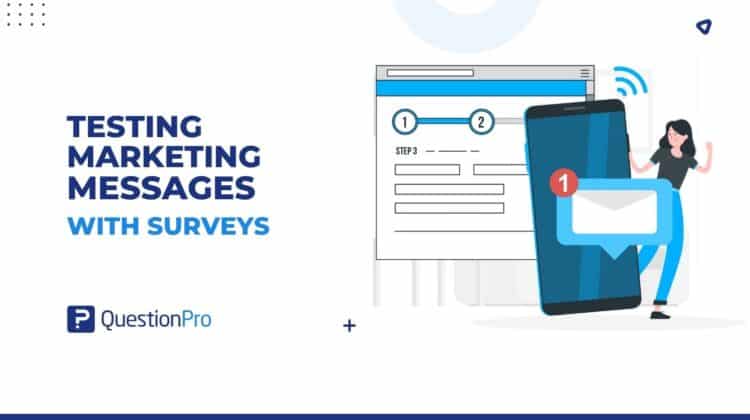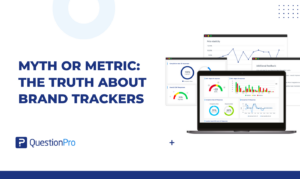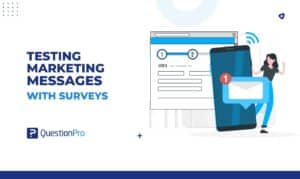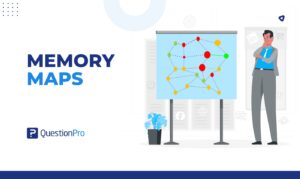
You don’t want to find out your marketing message isn’t working after you’ve spent money promoting it. Testing marketing messages with surveys helps you identify what resonates, what falls flat, and what needs refining before your campaign goes live.
With surveys, you can confirm your best ideas, measure which message works, and collect real feedback from your audience. You’ll see how people perceive your value, which promises connect, and whether the wording feels on brand.
In this guide, we’ll cover what message testing is, simple ways to run it, how to use surveys step by step, and a few best practices to ship with confidence.
What is Message Testing With Surveys?
Message testing with surveys means checking different versions of your message with real people before you launch. You show a few options and ask which one is clearer, more convincing, and feels on brand.
How it works:
- Pick 2 to 6 message ideas, like headlines or short ad copy.
- Ask simple questions to rate clarity, relevance, and motivation to act.
- Include open-ended questions to learn why people chose a message.
- Look at the results by audience segment to see which version works best for each group.
The outcome is a clear, evidence-based choice and quick edits to make your final message stronger.
Why Testing Marketing Messages Matters?
Testing lets you compare options with real audiences so you can confirm what resonates, fix weak spots, and align copy with your brand before you spend on ads or paid media. The result is clearer communication, fewer surprises, and a higher chance of hitting your goals at launch.
What you gain:
- Validate before launch: Reduce campaign risk by confirming message effectiveness with the right audience.
- Better performance: Improve CTR, conversion rate, and cost efficiency by rolling out proven headlines, subject lines, and calls to action.
- Stronger positioning: Ensure messages are consistent with brand positioning while speaking directly to customer needs and pain points.
- Segment clarity: See how results shift by persona or stage in the customer journey, then tailor copy for each group.
- Faster iteration: Use a repeatable process to test, refine, and re-test until your message is clear, persuasive, and ready to scale.
Testing also turns opinions into evidence you can act on. Surveys and quick experiments combine measurable rankings and ratings with open-ended “why” feedback.
You learn which value propositions connect with your target audience, how different segments react, and where wording creates confusion.
Survey Methods for Message Testing
Select the approach that fits your goal and resources, then use the ready-to-copy questions to run a clean, repeatable test. Each one balances speed, sample needs, and the depth of insight you’ll get.
1. A/B Test
A/B testing compares two versions of a message with two separate groups. Each person sees only one message, so results are clean and fast to interpret.
Question:
- Q1. Which message would make you more likely to click or learn more?
- Message A
- Message B
When to use: You have 2–3 messages and want a quick winner.
Pros: Simple, fast, easy to explain.
2. Monadic Testing
Monadic testing shows each respondent just one message to rate. This avoids direct comparisons and gives an unbiased read on each option.
Questions:
- How appealing is this message? 1 to 5
- Why did you give that rating?
When to use: You want clean, unbiased reactions to each option.
Pros: Reduces fatigue and comparison bias.
3. Sequential Monadic
Sequential monadic shows multiple messages to the same person in random order. You collect ratings for each message efficiently.
Questions:
- For each message:
Q1. How clear is this message? 1 to 5
- After all messages:
Q2. If you had to pick one for an ad, which would you choose?
When to use: You need efficient sample use across several options.
Pros: Fewer completes needed than pure monadic.
4. MaxDiff (Maximum Difference)
MaxDiff shows small sets of messages and asks which is most and least compelling. It builds a priority ranking across many options.
Questions:
Select the most compelling and the least compelling.
Set 1:
- Get projects done 30% faster with templates and guided workflows.
- Cut monthly software spend by consolidating tools into one simple platform.
- Start in minutes with no setup, then scale as your team grows.
Q1. Most compelling
Q2. Least compelling
When to use: You need a ranked list across many messages.
Pros: Strong prioritization and less scale bias.
5. Conjoint (Message Attribute Testing)
Conjoint tests combinations of elements like tone, Benefit, and CTA to see which mix drives choice. It reveals what parts matter most.
Questions:
- Choice task: Which would you be more likely to click?
- Option A
- Option B
- Optional: Which single element mattered most?
When to use: You want to learn which parts of a message drive choice.
Pros: Shows trade-offs and the optimal bundle.
Select the method that matches your goal, timeline, and sample. That way, you choose a message with confidence and clear next steps for refinement.
What Questions to Ask in a Message-Testing Survey
The right questions help you understand not just whether people like your message, but why it works or doesn’t. A strong message-testing survey mixes emotional, clarity, and action-focused questions. Below are examples you can use in your survey:
Understanding clarity & relevance
- How clear is this message to you?
- Very clear
- Somewhat clear
- Neutral
- Slightly unclear
- Not clear at all
Evaluating emotional impact
- How strongly do you agree with this statement?
It’s a single Likert-type question using an agree–disagree scale.
Measuring differentiation
- Compared to other brands, this message feels:
- Very unique
- Somewhat unique
- Average
- Similar
- Same as others
Judging action intent
- How likely are you to take action after seeing this message?
- Very likely
- Not likely
Open-ended feedback
- What do you like most about this message?
- What would you change to improve it?
- If you could rewrite this message in your own words, what would you say?
Step-by-Step Guide to Use Surveys for Testing Marketing Messages
Survey-based message testing lets you compare different messages and see which resonates most with your audience. By blending ratings, rankings, and open-ended questions, you get a complete view of message effectiveness.
This approach blends quantitative research with qualitative research to give marketing teams a complete picture of how their communication strategies perform.

Step 1. Set objectives and define your target market
Start by deciding what you want to test, such as subject lines, ad copy, landing pages, or brand positioning statements. Then select the right audience segment or buyer persona so feedback comes from the people most likely to respond to your future campaigns.
Step 2. Create message variations
Prepare two or more versions of your messaging. Test different ad copies with unique value propositions or alternative landing page headlines to see which resonates best with your audience. You might ask:
- Which of these headlines makes you more likely to explore the product?
- Which ad copy feels clearer and more persuasive to you?
Step 3. Design survey questions
Use a mix of quantitative methods and qualitative feedback. For example:
- Ask respondents to rate which subject line is more appealing on a scale of 1–5.
- Use ranking questions to prioritize different brand messaging approaches.
- Include open-ended questions to gather deeper insights into why a message resonates (or doesn’t).
Step 4. Collect and analyze responses
Distribute the survey through email, SMS, intercept surveys, or social links. Review both quantitative data (like which subject line scored highest) and qualitative feedback (like why respondents preferred one version).
Step 5. Refine your messaging strategy
Apply the insights you collect to strengthen your campaigns. Use the results to refine messaging and ensure consistency across all touchpoints. For example:
- Roll out the winning subject line in your emails.
- Adjust or simplify brand statements that caused confusion.
Run iterative tests to continually improve your messaging until it is consistent, on-brand, and optimized for higher conversion rates.
Metrics to Evaluate Message Effectiveness with Surveys
Start with a clean winner metric, then verify clarity, motivation, and brand fit, and capture the “why” from open-ended feedback.
- Identify the Top Choice
Measure the percentage selecting each message in head-to-head or multi-option tests. This is your primary indicator of preference and resonance.
- Measure Clarity
Use a top-2 box on This message is clear. Target benchmark 70%+ to reduce launch-stage confusion.
- Understand the “Why”
Text analytics helps surface trends at scale. Analyze open-ended responses to uncover:- Key themes
- Emotional triggers
- Objections
- Language worth preserving
- Prioritize When Testing Many Messages
When comparing multiple claims or variations, use:- MaxDiff to rank the strongest message themes
- Conjoint analysis to see which components (tone, benefit, CTA) drive choice and action
- Validate in the Real World
Track lift vs. control to verify true market impact. Post-launch, confirm survey insights with performance metrics such as:- Click-through rate (CTR)
- Conversion rate
- Cost per click/cost per qualified lead
- Bounce rate & time on page
- Simple Decision Rule
Use motivation, brand fit, and open-ended insights as tie-breakers. Refine if qualitative feedback signals risk. Choose the message that:- Has the highest preference score
- Meets or exceeds 70% clarity
Measure what wins, explain why it wins, and verify it in the market. This tight loop turns survey results into messages that perform when the budget is on the line.
Best Practices for Successful Message Testing
Message testing works best when it follows a structured and strategic approach. To get meaningful results, marketing teams should keep these practices in mind:
- Align with the buyer persona and the customer’s journey: Test messages that match your target audience, as new leads and existing customers may respond differently.
- Use diverse perspectives and audience segments: Include multiple demographics to see how different groups react.
- Apply an iterative process to refine messages that resonate: Test, refine, and re-test to keep improving your messaging.
- Validate before launch to optimize marketing efforts: Confirm messages work with potential customers before a full rollout.
By combining surveys, qualitative feedback, and quantitative research, marketing teams can refine messages that resonate, reduce campaign risk, and connect more effectively with their target audience before launch.
How to Test Marketing Messages with QuestionPro Survey?
QuestionPro survey platform offers a wide range of tools that make it easier for marketing teams to validate messaging before launch and minimize campaign risk:

- You can run a survey with different types of questions, such as multiple-choice, ranking, Likert, and open-ended questions, to see what works and why.
- Get quick reactions to taglines, visuals, or short copy on your site or social channels with polls.
- Compare two or more versions in email, landing pages, or ads with A/B testing. Track opens, clicks, and conversions to confirm performance.
- Use conjoint analysis to test combinations of tone, benefit, and CTA to find the mix that drives choice.
- With the MaxDiff scale, QuestionPro helps you to show short claims and ask for the most and least compelling to create a clear ranking.
- You can use text analytics and sentiment to analyze open-ended comments with AI to find themes, emotions, and objections fast.
These tools enable marketing teams to gather both quantitative data and qualitative insights, delivering a complete picture of message effectiveness before committing to large-scale campaigns.
Conclusion
We learned to use surveys to test marketing messages and their best practices. Using Surveys to test marketing messages gives you a structured way to validate ideas before you launch a full campaign. It is a strategy to optimize budgets, improve conversion rates, and ensure every campaign speaks directly to its intended audience.
With tools like A/B testing, conjoint analysis, and real-time dashboards, QuestionPro makes it easy to collect feedback and turn it into insights.
Testing marketing messages with surveys is not just a precaution; it’s a strategy to optimize budgets, improve conversion rates, and build targeted campaigns.
Frequently Asked Questions (FAQs)
Answer: Testing marketing messages before launch helps reduce risk by validating ideas with real audiences. It ensures that campaigns resonate with the target market and prevent wasted spend on messaging that doesn’t connect.
Answer: Surveys provide both quantitative data and qualitative feedback. They allow you to measure effectiveness through ratings, rankings, and open-ended responses, giving you a complete view of which messages perform best and why.
Answer: A/B testing allows you to compare different versions of taglines, calls-to-action, or subject lines with audience segments. By tracking engagement and responses, you can identify the most persuasive variation before scaling up campaigns.
Answer: Yes. By validating messages in advance, businesses avoid costly missteps, optimize ad spend, and improve conversion rates. Testing ensures campaigns are both customer-centric and budget-efficient.
Answer: Modern survey platforms offer advanced logic, distribution tools, A/B testing modules, conjoint and MaxDiff analysis, focus group integration, and real-time dashboards.







